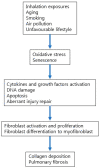Environmental Causes of Idiopathic Pulmonary Fibrosis
- PMID: 38003670
- PMCID: PMC10671449
- DOI: 10.3390/ijms242216481
Environmental Causes of Idiopathic Pulmonary Fibrosis
Abstract
Idiopathic pulmonary fibrosis (IPF), the most common and severe of the idiopathic interstitial pneumonias, is a chronic and relentlessly progressive disease, which occurs mostly in middle-aged and elderly males. Although IPF is by definition "idiopathic", multiple factors have been reported to increase disease risk, aging being the most prominent one. Several occupational and environmental exposures, including metal dust, wood dust and air pollution, as well as various lifestyle variables, including smoking and diet, have also been associated with an increased risk of IPF, probably through interaction with genetic factors. Many of the predisposing factors appear to act also as trigger for acute exacerbations of the disease, which herald a poor prognosis. The more recent literature on inhalation injuries has focused on the first responders in the World Trade Center attacks and military exposure. In this review, we present an overview of the environmental and occupational causes of IPF and its pathogenesis. While our list is not comprehensive, we have selected specific exposures to highlight based on their overall disease burden.
Keywords: environmental exposures; idiopathic pulmonary fibrosis; interstitial lung disease; occupational exposures.
Conflict of interest statement
The authors declare no conflict of interest.
Figures
Similar articles
-
The Role of Occupational and Environmental Exposures in the Pathogenesis of Idiopathic Pulmonary Fibrosis: A Narrative Literature Review.Medicina (Kaunas). 2018 Dec 10;54(6):108. doi: 10.3390/medicina54060108. Medicina (Kaunas). 2018. PMID: 30544758 Free PMC article. Review.
-
[Research progress of occupational and environmental exposure and idiopathic pulmonary fibrosis].Zhonghua Lao Dong Wei Sheng Zhi Ye Bing Za Zhi. 2022 Oct 20;40(10):790-794. doi: 10.3760/cma.j.cn121094-20210309-00132. Zhonghua Lao Dong Wei Sheng Zhi Ye Bing Za Zhi. 2022. PMID: 36348566 Chinese.
-
Occupational and environmental risk factors for idiopathic pulmonary fibrosis: A case-control study.Respir Med. 2024 Sep;231:107738. doi: 10.1016/j.rmed.2024.107738. Epub 2024 Jul 9. Respir Med. 2024. PMID: 38992818
-
Occupational and environmental risk factors for idiopathic pulmonary fibrosis in Australia: case-control study.Thorax. 2020 Oct;75(10):864-869. doi: 10.1136/thoraxjnl-2019-214478. Epub 2020 Jul 13. Thorax. 2020. PMID: 32660982
-
The Impact of Occupational Exposures on the Risk of Idiopathic Pulmonary Fibrosis: A Systematic Review and Meta-Analysis.Ann Am Thorac Soc. 2024 Mar;21(3):486-498. doi: 10.1513/AnnalsATS.202305-402OC. Ann Am Thorac Soc. 2024. PMID: 38096107 Free PMC article.
Cited by
-
Pulmonary fibrosis: pathogenesis and therapeutic strategies.MedComm (2020). 2024 Sep 23;5(10):e744. doi: 10.1002/mco2.744. eCollection 2024 Oct. MedComm (2020). 2024. PMID: 39314887 Free PMC article. Review.
-
Combination of HSP90 Inhibitors and HSP70 Inducers Prevent Hydrochloric Acid-Induced Pulmonary Fibrosis in Rabbits.Int J Mol Sci. 2025 Jan 7;26(2):441. doi: 10.3390/ijms26020441. Int J Mol Sci. 2025. PMID: 39859156 Free PMC article.
-
ACSL1 improves pulmonary fibrosis by reducing mitochondrial damage and activating PINK1/Parkin mediated mitophagy.Sci Rep. 2024 Nov 3;14(1):26504. doi: 10.1038/s41598-024-78136-5. Sci Rep. 2024. PMID: 39489819 Free PMC article.
-
Sivelestat sodium: a novel therapeutic agent in a mouse model of acute exacerbation pulmonary fibrosis through multiple mechanisms.J Thorac Dis. 2025 Jul 31;17(7):5024-5043. doi: 10.21037/jtd-2025-163. Epub 2025 Jul 29. J Thorac Dis. 2025. PMID: 40809237 Free PMC article.
-
Adverse outcome pathway-based assessment of pulmonary toxicity from the in vivo mixture of biocides dinotefuran and cetylpyridinium chloride.Heliyon. 2025 Jan 20;11(2):e42134. doi: 10.1016/j.heliyon.2025.e42134. eCollection 2025 Jan 30. Heliyon. 2025. PMID: 39925360 Free PMC article.
References
-
- Raghu G., Collard H.R., Egan J.J., Garcia C.A., Azuma A., Behr J., Brozek J.L., Collard H.R., Cunningham W., Homma S., et al. An Official ATS/ERS/JRS/ALAT Statement: Idiopathic Pulmonary Fibrosis: Evidence-based Guidelines for Diagnosis and Management. Am. J. Respir. Crit. Care Med. 2011;183:788–824. doi: 10.1164/rccm.2009-040GL. - DOI - PMC - PubMed
-
- Raghu G., Rochwerg B., Zhang Y., Garcia C.A., Azuma A., Behr J., Brozek J.L., Collard H.R., Cunningham W., Homma S., et al. An Official ATS/ERS/JRS/ALAT Clinical Practice Guideline: Treatment of Idiopathic Pulmonary Fibrosis. An Update of the 2011 Clinical Practice Guideline. Am. J. Respir. Crit. Care Med. 2015;192:e3–e19. doi: 10.1164/rccm.201506-1063ST. - DOI - PubMed



